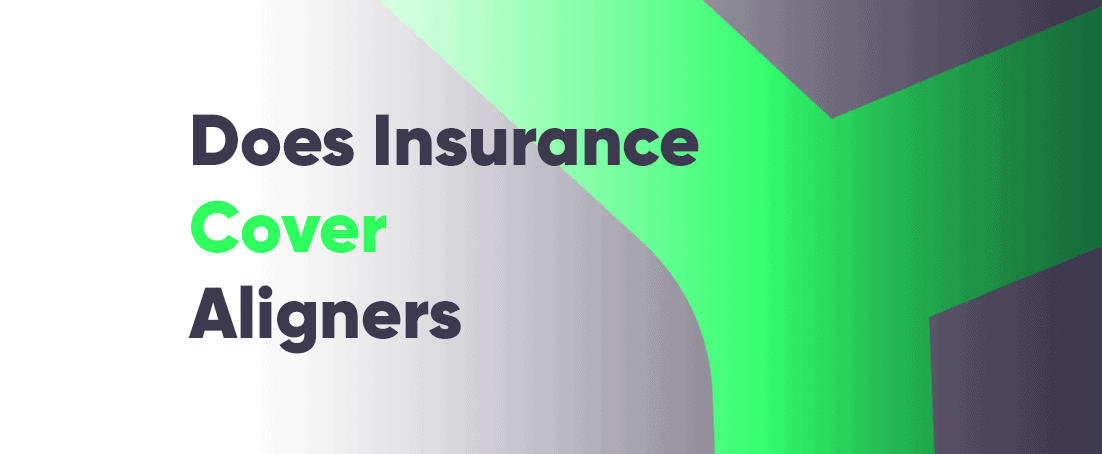Dental appliances can be significantly expensive, making insurance coverage essential. Various dental insurance plans cover aligner treatments, similar to the coverage for traditional braces. Specific percentages or fixed amounts can be allocated for the coverage, plus a lifetime cap.
Some plans may exclude aligners for adults, deeming them cosmetic rather than medical. As coverage varies widely, it’s vital to consult your insurance provider to clearly understand your coverage’s specifics and any restrictions. Let’s unfold which aligner brands are covered under the common insurance plans and explore the possibility of getting your aligners covered with insurance.
Table of Contents:
Types of Insurance
Before coming to the question “Does insurance cover aligners?”, we need to have an understanding of the various insurance plans in the USA catering to different needs related to medical and health services:
Health Maintenance Organization (HMO):
The HMO plan limits coverage to in-network doctors, emphasizing integrated care and preventive measures.
Preferred Provider Organization (PPO):
Offering a network of preferred providers, PPOs encourage their use by providing financial incentives. It does cover a greater share of costs for out-of-network providers.
Exclusive Provider Organization (EPO):
Services under EPOs are covered only within the plan’s network, except during emergencies, ensuring managed care.
Point of Service (POS):
These plans offer reduced costs for in-network healthcare providers, requiring referrals from primary care doctors to see specialists. Coverage for oral appliances such as braces, retainers, aligners, and night guard insurance may fall under these health plans’ coverage, but specifics vary among insurers.
Flexible Spending Accounts (FSAs) and Health Savings Accounts (HSAs) also serve as effective tools for managing healthcare expenses, covering a broad spectrum of medical and dental costs.
Flexible Spending Account (FSA)
An FSA, set up by an employer, permits employees to allocate a portion of pre-tax earnings toward qualified medical expenses, reducing taxable income. While versatile for medical needs, FSA funds generally do not carry over yearly, with potential grace periods for unused funds.
Health Savings Account (HSA)
An HSA, linked to a high-deductible health plan, allows both employers and employees to contribute, with deposits not subject to federal income tax. Health Saving Account funds can pay for your medical expenses, including dental services. They roll over annually, allowing long-term savings and investment growth.
Insurance Coverage of Braces and Aligners
There might be some hindrances while seeking insurance coverage for braces or aligners. Dental insurance often offers partial coverage for orthodontic treatments, encompassing both braces and clear aligners. However, coverage specifics fluctuate among plans.
Consider the payment arrangements and insurance coverage when considering them as a treatment for misaligned teeth. Depending on the brand, some aligners may not receive uniform coverage. Insurance companies might extend benefits for aligners, but the terms and expenses differ widely.
To sum up, understanding your insurance plan’s orthodontic benefits is crucial to managing the payment process effectively.
Are Aligners Dental or Medical Expenses?
Misaligned teeth pose functional challenges beyond aesthetics, impacting oral hygiene and muscle strain during biting. Aligners offer a solution, and it’s reasonable to expect your health insurance plan to pay for them.
In general, aligners are considered a dental expense. However, this classification can vary based on different factors, such as the aligner brand and type, location, and an orthodontist’s evaluation. Dental insurance typically offers partial coverage, subject to plan variations and limitations like lifetime caps.
Types of Dental Insurance Coverage
Many dental insurance plans cover orthodontic treatments like aligners and braces in the USA. If we compare aligners vs retainers in terms of coverage, the former is more insurance-friendly. You might need to pay for the retainers out of your pocket if your insurance plan doesn’t cover follow-up to orthodontic treatment.
- Health Maintenance Organization (HMO): HMO plans may cover aligners and braces, albeit with limitations to in-network providers. However, coverage for retainers post-treatment might vary.
- Preferred Provider Organization (PPO): PPO plans typically cover braces, aligners, and a percentage of orthodontic treatments. However, insurance cover for follow-up might differ between in-network and out-of-network providers.
- Exclusive Provider Organization (EPO): EPO plans may cover aligners and braces within their network, but the coverage for retainers might be specific to in-network services.
- Point of Service (POS): POS plans often cover a portion of orthodontic treatments, including aligners and braces, with reduced costs for in-network providers.
Aligner Insurance Coverage by Brand
- Straight My Teeth: Offers flexible payment plans and accepts most major dental insurance, including Medicaid, ensuring partial coverage.
- Byte: Partners with insurers, potentially offering up to 50% coverage for the Byte aligner cost depending on your plan. It also accepts most major dental insurance.
- ALIGNERCO: Coverage varies per insurance policy, some covering clear aligners as part of orthodontic plans, accepting most major dental insurance.
- Candid: Candid aligners are typically considered dental expenses, but they accept major dental insurance plans, ensuring partial coverage.
- NewSmile: Most dental plans pay a portion, and their cost is 75% less than other brands, accepting major insurance for partial coverage.
It’s vital to confirm coverage specifics and limitations with your insurer for each aligner brand. Some providers, like Byte, facilitate aligner coverage through partnerships with insurers.
How to Pay with Insurance?
- Enrollment: Begin by enrolling in a dental insurance program that covers orthodontic treatments like aligners. Choose a plan that aligns with your needs and covers the desired aligner brand.
- Verification: Verify the coverage details related to orthodontic treatments, aligners, and any limitations or requirements. Understand the extent of coverage, including percentages or fixed amounts covered by the insurance plan.
- Orthodontist Consultation: Consult an orthodontist within the insurance network. Discuss treatment options, aligner brands, and the coverage under your insurance plan. Ensure the chosen aligner brand is compatible with your insurance coverage.
- Treatment Plan Approval: Once the treatment plan is finalized with the orthodontist, seek approval or pre-authorization from the insurance provider. This step validates the coverage and treatment plan before proceeding.
- Claim Submission: The orthodontist submits a claim to the insurance company for the proposed clear aligner treatment. This claim includes details of the treatment plan, estimated costs, and any pre-authorization obtained.
- Coverage Confirmation: Upon receiving the claim, the insurance company assesses it and confirms the coverage and reimbursement amount. They may approve the claim, specifying the portion they will pay and any out-of-pocket expenses.
- Aligner Procurement: With the insurance coverage confirmed, proceed with acquiring the aligners from the chosen provider. Ensure compliance with any co-payment or deductible requirements stipulated by the insurance plan.
- Treatment Initiation: Commence the aligner treatment as prescribed by the orthodontist, utilizing the insurance coverage for the eligible expenses. Keep track of payments and receipts for future reference and reimbursement purposes.
Teeth Aligner Cost Without Insurance
In the USA, the cost range of teeth aligners varies, with the cheapest teeth aligners starting from $1,000 and expensive ones going as much as $10,000. In-office clear aligners, like Invisalign treatment, often cost more than at-home treatments, which typically range from $1,200 to $2,000 without insurance.
Aligners insurance coverage can substantially reduce these expenses, with some plans covering up to 25% of the total cost, easing the financial burden on patients.
Choosing Between Aligners or Braces without Insurance Coverage?
Opting for dental aligners without insurance coverage is often a preferable choice. You can expect to pay $1,200 to $2,000 for at-home aligner treatments, whereas braces can cost between $1,800 to $10,000 without insurance.
Aligners are subtler, less painful, and often accompanied by flexible payment plans, easing the financial strain compared to braces. However, costs may vary, so researching different providers is crucial for budget and orthodontic considerations. I recommend reading our article on do aligners work to figure out whether they will be effective for you.
Conclusion
For those without insurance, dental aligners are the more cost-effective and comfortable choice compared to braces for teeth straightening. Insurance companies and brands post information regarding their policies and insurance plans online. Looking them up can offer valuable insights into coverage specifics and aid in making informed decisions about orthodontic treatments.

